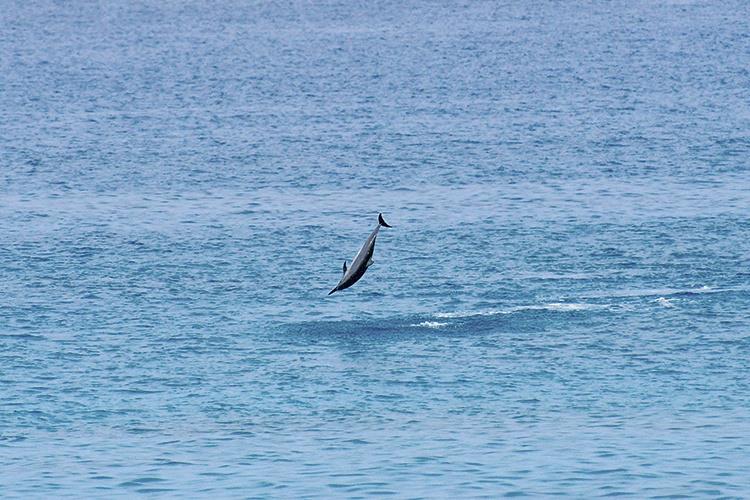
Snorkelers fined for pursuing Hawaiian Spinner Dolphins
by Joseph Bennington-Castor 8 Sep 2018 13:14 UTC

A Hawaiian spinner dolphin performs aerial acrobatics off Makua Beach, Oahu © NOAA Fisheries
Three recreational swimmers — two Hawaii residents and one visitor — have now paid individual summary settlements for harassing Hawaiian spinner dolphins off Makua Beach on Oahu, Hawaii.
Two patrolling enforcement officers with NOAA's Office of Law Enforcement (OLE) initially saw the dolphins performing aerial acrobatics. They then noticed swimmers apparently pursuing the small pod of dolphins.
The officers watched and video-recorded the marine activities for 15 minutes. They saw not only that the swimmers were clearly pursuing the animals, but also that the pursuit was causing marked behavioral changes in the dolphins, including tail slaps and quick changes in direction, in addition to the aforementioned aerial displays.
Importantly, Hawaiian spinner dolphins are protected under the Marine Mammal Protection Act, or MMPA, which prohibits any attempt to harass, hunt, capture, or kill a marine mammal (activities considered to be a "take"). Harassment includes any act of pursuit, torment, or annoyance that could injure the animals or disrupt their normal behavioral patterns.
The OLE officers issued penalties according to the NOAA General Counsel summary settlement schedule, a policy that outlines how penalties should be issued, to the three swimmers for violating the MMPA. One of these swimmers was familiar with the regulations.
Though recreational ocean users received penalties in this case, the MMPA regulations apply to commercial entities as well. In 2017, a judge fined a dolphin tour operator on Hawaii Island for illegally harassing spinner dolphins.
"Some people go out there knowing that it's potentially illegal [to interact with dolphins]," says Adam Kurtz, a NOAA Fisheries wildlife management coordinator. "These cases serve as a reminder to everyone that there are consequences for harassing spinner dolphins, and it's possible to get fined if you pursue them in violation of the law."
NOAA recommends everyone keep a respectful distance of at least 50 yards from spinner dolphins and to not pursue them.
If you witness a potential MMPA violation in Hawaii, call NOAA OLE at 1-800-853-1964. Email photos or videos to . To report general marine animal emergencies, call NOAA's statewide reporting number at 1-888-256-9840.
The Need for Rest
Hawaiian spinner dolphins have a cyclical daily pattern. They spend their nights offshore in large groups to feed; in the morning, they return in smaller groups to select bays and nearshore areas around the islands to rest, socialize, nurture their young, and avoid predators.
The dolphins are known to perform aerial displays while entering or leaving their resting bays, but they're significantly less active while in their nearshore habitat. They sleep while they swim back and forth, keeping one-half of their brain at a low level of alertness for predators, obstacles, and other animals.
When disturbed, such as by an approaching swimmer, kayak, or boat, the dolphin will wake up to assess the potential threat and respond appropriately, losing important rest time.
Occasionally, some individuals in the pod may appear to want to interact with people in the water, but for the most part these dolphins are possibly just curious juveniles while the rest of the pod tries to avoid human interaction, Kurtz says.
Though a single disturbance may seem inconsequential, nearshore pods frequently experience numerous disturbances throughout the day from commercial dolphin tours and recreational viewers. Research shows that spinners in some resting bays in Hawaii encounter potentially disruptive human activity about 82% of the time, with only about 10 minutes of reprieve between interactions.
This disturbance is akin to strangers bothering you for 6.5 hours every night and leaving you alone to rest for only 10 minutes at a time.
But what happens if you are in the water and a pod of spinner dolphins approaches you or swims past you?
In such cases, NOAA recommends that you refrain from touching, moving towards, or following after them — avoid accidentally violating the law by allowing the dolphins to behave naturally. Even slow, subtle movements towards the dolphins can make them aware of your presence. Allow the dolphins to pass by and let them resume resting undisturbed.
New Regulations Coming
Though unauthorized take of marine mammals — including harassment of spinner dolphins —already is and continues to be prohibited under the MMPA throughout their range, NOAA has proposed new regulations that identify and prohibit specific human activities that result in take of spinner dolphins.
If implemented, the proposed new regulations would prohibit anyone from swimming with Hawaiian spinner dolphins or approaching them within 50 yards, helping to reduce disturbance and disruption of important Hawaiian spinner dolphin behaviors in areas where human-dolphin interactions are most likely to occur.
Upon implementation, NOAA Fisheries officials will engage in wide-spread efforts to ensure all ocean users are aware of the newly defined regulation regarding spinner dolphin approach. Education and outreach is a high priority for NOAA Fisheries and OLE.
"NOAA Fisheries would much rather choose education over enforcement because it prevents incidents from happening in the first place," Kurtz says. "But enforcement comes in when education doesn't work."
Getting the chance to see Hawaiian spinner dolphins and other marine wildlife in Hawaii can be an amazing experience. While the new spinner dolphin regulation is not yet finalized, NOAA Fisheries' Wildlife Viewing Guidelines and Dolphin SMART guidelines outline appropriate viewing distances that promote wildlife tourism that is safe for both animals and people — such as the 50-yard minimum for watching dolphins.
Collaboratively managed by government agencies and NGOs, Dolphin SMART is a partnership program that works with the tourism industry to foster responsible stewardship of dolphins and other marine wildlife. It recognizes tour companies that voluntarily follow specific Dolphin SMART criteria to minimize dolphin harassment and educate customers about dolphin and marine wildlife conservation.
Viewing Hawaii's marine wildlife responsibly and sustainably helps ensure that these species will remain healthy for us to enjoy for generations to come.